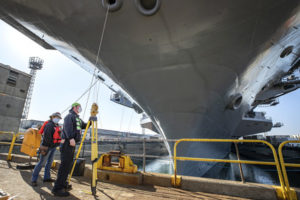The Nimitz-class aircraft carrier USS Carl Vinson (CVN-70) left dry dock this week as the Navy is finishing a maintenance period in Bremerton, Wash., while also altering work schedules amid the COVID-19 pandemic.
The Vinson has been undergoing a 14-month Docking Planned Incremental Availability (DPIA) at Puget Sound Naval Shipyard & Intermediate Maintenance Facility (PNS & IMF) in Bremerton and the carrier left the Dry Dock 6 on April 6.

During this availability, the maintainer team worked on major components of the ship and also prepared the carrier to handle F-35C Lighting II Joint Strike Fighters.
In December 2018, the first F-35C operations squadron finished carrier qualifications aboard the Vinson (Defense Daily, Dec. 14, 2018).
Project superintendent Mike Irby noted the shafts, rudders and bearings had “significant material deficiencies” that delayed undocking while the rudders, rudder bores and struts also “required extensive repairs.”
The Navy noted “due to the massive amount of growth work, the availability is currently projected to finish three weeks late.”
However, the Navy said the CVN-70 maintenance team got a head start on the DPIA by ensuring some work was done in San Diego before the ship arrived in Bremerton in January 2019.
“The team conducted multiple ship visits and assessments to fully scope the work required before the ship arrived, and leveraged lessons learned and improvements that were implemented during the USS Nimitz (CVN-68) DPIA at PSNS & IMF from March 2018 to June 2019,” the Navy added.
The overall DPIA work included upgrades to the electrical system; maintenance on the rudders, shafts and tanks; upgrades to crew living space; work to preserve ship’s hull; and upgrades to the ship combat systems.
The Navy noted it had to change some maintenance schedules to help mitigate the spread of the COVID-19 pandemic.
“As we all watch the news and see the ways COVID-19 is challenging our nation and our Navy, we remain committed to delivering ships to support the warfighters’ needs. The current pandemic has certainly challenged us, but we pulled together as a team, alongside the ship’s force and all of our other partners to get this aircraft carrier back in the water,” Capt. Dianna Wolfson, commander of PSNS & IMF, said in a statement.
Late last month PSNS & IMF adjusted policies and procedures to help protect the workforce. As of March 24 the shipyard has 2,001 people teleworking, was distributing laptops from those who could not work from home to those who could. The shipyard noted those who can work from home represent 15 percent of the workforce.
Shipyard leadership also implemented alternate work schedules to limit the number of people working in an area at a time, splitting the normal daytime workforce into a day and second shift.
This is “reducing the flow of individuals in and out of the shipyard at any given time as well as reducing the number of people each individual has contact with during a given day for the purpose of social distancing,” the shipyard said in a March 27 statement.
Irby said reducing the workforce in these ways did not dampen work efforts.
“Despite the challenges, the shipyard and the project team maintained their focus and successfully prioritized undocking the ship,” Irby said.
“Despite being late to get the ship out of dock, we are all laser-focused on gaining efficiencies that will, in the end, pull the availability completion date to the left,” he said.